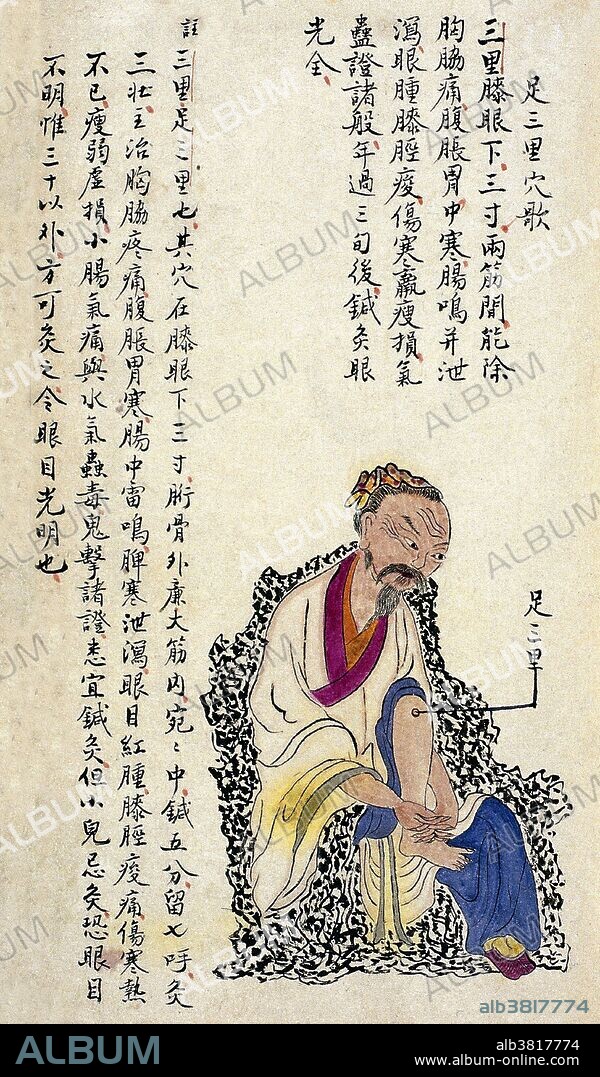alb3817774
Chinese Acu-moxa Point Chart, 1869

|
Add to another lightbox |
|
Add to another lightbox |



Title:
Chinese Acu-moxa Point Chart, 1869
Caption:
Acu-moxa point chart, showing the zu san li (Leg Three Miles) point, from Chuanwu lingji lu (Record of Sovereign Teachings), by Zhang Youheng, a treatise on acu-moxa in two volumes. This work survives only in a manuscript draft, completed in 1869 (8th year of the Tongzhi reign period of the Qing dynasty). The text states: The zu san li point is located 3 cun below the the lateral depression of the knee (xiyan, Eye of the Knee), between the two tendons at the outer edge of the tibia. It can be needled to a depth of 5 fen, and moxibusted with three moxa cones. It is indicated for pain in the chest and sides; abdominal distension; diarrhea related to cold in the spleen and stomach; red, swollen eyes; aching knees and shins; frailty and emaciation and insufficiency detriment consequent upon cold damage; gaseous pain in the small intestine; water Qi/oedema (shuiqi) from insect poisoning, etc. Moxibustion of this point is prohibited for child patients, as it may damage the eyes. Only in the case of patients over the age of thirty, moxibustion at zu san li can improve the eyesight.
Credit:
Album / Science Source / Wellcome Images
Releases:
Model: No - Property: No
Rights questions?
Rights questions?
Image size:
2814 x 4800 px | 38.6 MB
Print size:
23.8 x 40.6 cm | 9.4 x 16.0 in (300 dpi)
Keywords:
1860S • 1869 • 19TH CENTURY • ACU-MOXA POINT CHART • ACU-MOXA • ACUPUNCTURE POINTS • ACUPUNCTURE • ALTERNATIVE MEDICINE • ALTERNATIVE THERAPY • ANCIENT • ANTIQUITY • ART • ARTWORK • ASIAN • CALLIGRAPHY • CHART • CHINA • CHINESE CALLIGRAPHY • CHINESE CHARACTERS • CHINESE SCRIPT • CHINESE WRITING • CHINESE • CHUANWU LINGJI LU • DIAGRAM • DRAWING • FULL FIGURE • GREAT QING • HISTORIC • HISTORICAL • HISTORY • ILLUSTRATION • INSTRUCTIONAL • LEG THREE MILES POINT • MALE • MAN • MANCHU DYNASTY • MEDICAL • MEDICINAL • MEDICINE • MEN • MOXIBUSTION POINTS • MOXIBUSTION • PSEUDO-SCIENCE • PSEUDOSCIENCE • QING DYNASTY • QING EMPIRE • SCIENCE • TCM • THERAPEUTIC • THERAPY • TRADITIONAL CHINESE MEDICINE • TREATMENT CHART • TREATMENT • WOODBLOCK • WOODCUT • WRITING SYSTEM • WRITING • WRITING: CHINESE • XYLOGRAPHY • ZHANG YOUHENG • ZU SAN LI POINT
 Pinterest
Pinterest Twitter
Twitter Facebook
Facebook Copy link
Copy link Email
Email
